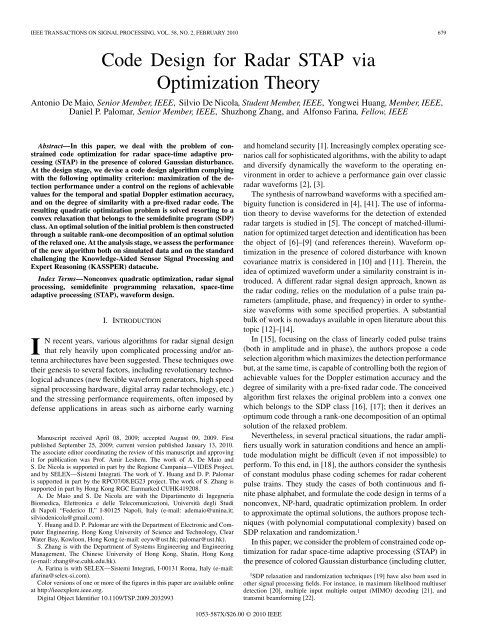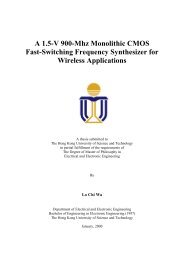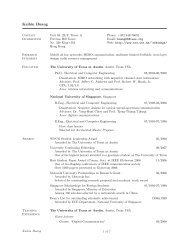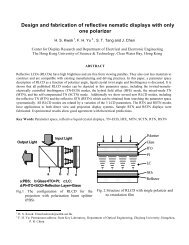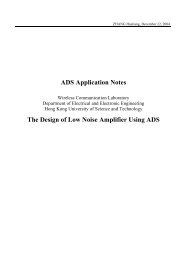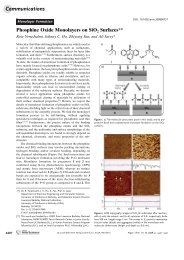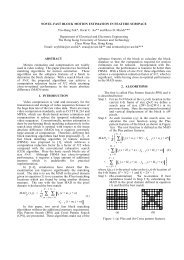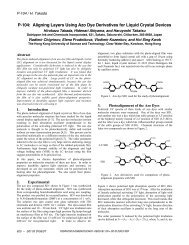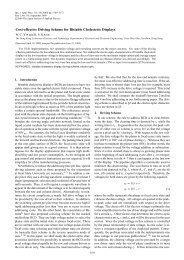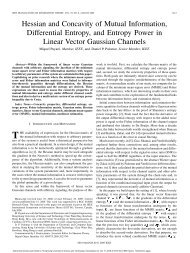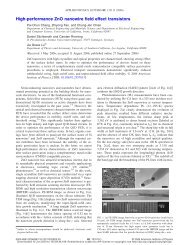Code Design for Radar STAP via Optimization Theory
Code Design for Radar STAP via Optimization Theory
Code Design for Radar STAP via Optimization Theory
Create successful ePaper yourself
Turn your PDF publications into a flip-book with our unique Google optimized e-Paper software.
IEEE TRANSACTIONS ON SIGNAL PROCESSING, VOL. 58, NO. 2, FEBRUARY 2010 679<strong>Code</strong> <strong>Design</strong> <strong>for</strong> <strong>Radar</strong> <strong>STAP</strong> <strong>via</strong><strong>Optimization</strong> <strong>Theory</strong>Antonio De Maio, Senior Member, IEEE, Silvio De Nicola, Student Member, IEEE, Yongwei Huang, Member, IEEE,Daniel P. Palomar, Senior Member, IEEE, Shuzhong Zhang, and Alfonso Farina, Fellow, IEEEAbstract—In this paper, we deal with the problem of constrainedcode optimization <strong>for</strong> radar space-time adaptive processing(<strong>STAP</strong>) in the presence of colored Gaussian disturbance.At the design stage, we devise a code design algorithm complyingwith the following optimality criterion: maximization of the detectionper<strong>for</strong>mance under a control on the regions of achievablevalues <strong>for</strong> the temporal and spatial Doppler estimation accuracy,and on the degree of similarity with a pre-fixed radar code. Theresulting quadratic optimization problem is solved resorting to aconvex relaxation that belongs to the semidefinite program (SDP)class. An optimal solution of the initial problem is then constructedthrough a suitable rank-one decomposition of an optimal solutionof the relaxed one. At the analysis stage, we assess the per<strong>for</strong>manceof the new algorithm both on simulated data and on the standardchallenging the Knowledge-Aided Sensor Signal Processing andExpert Reasoning (KASSPER) datacube.Index Terms—Nonconvex quadratic optimization, radar signalprocessing, semidefinite programming relaxation, space-timeadaptive processing (<strong>STAP</strong>), wave<strong>for</strong>m design.I. INTRODUCTIONIN recent years, various algorithms <strong>for</strong> radar signal designthat rely heavily upon complicated processing and/or antennaarchitectures have been suggested. These techniques owetheir genesis to several factors, including revolutionary technologicaladvances (new flexible wave<strong>for</strong>m generators, high speedsignal processing hardware, digital array radar technology, etc.)and the stressing per<strong>for</strong>mance requirements, often imposed bydefense applications in areas such as airborne early warningManuscript received April 08, 2009; accepted August 09, 2009. Firstpublished September 25, 2009; current version published January 13, 2010.The associate editor coordinating the review of this manuscript and approvingit <strong>for</strong> publication was Prof. Amir Leshem. The work of A. De Maio andS. De Nicola is supported in part by the Regione Campania—VIDES Project,and by SELEX—Sistemi Integrati. The work of Y. Huang and D. P. Palomaris supported in part by the RPC07/08.EG23 project. The work of S. Zhang issupported in part by Hong Kong RGC Earmarked CUHK419208.A. De Maio and S. De Nicola are with the Dipartimento di IngegneriaBiomedica, Elettronica e delle Telecomunicazioni, Università degli Studidi Napoli “Federico II,” I-80125 Napoli, Italy (e-mail: ademaio@unina.it;silviodenicola@gmail.com).Y. Huang and D. P. Palomar are with the Department of Electronic and ComputerEngineering, Hong Kong University of Science and Technology, ClearWater Bay, Kowloon, Hong Kong (e-mail: eeyw@ust.hk; palomar@ust.hk).S. Zhang is with the Department of Systems Engineering and EngineeringManagement, The Chinese University of Hong Kong, Shatin, Hong Kong(e-mail: zhang@se.cuhk.edu.hk).A. Farina is with SELEX—Sistemi Integrati, I-00131 Roma, Italy (e-mail:afarina@selex-si.com).Color versions of one or more of the figures in this paper are available onlineat http://ieeexplore.ieee.org.Digital Object Identifier 10.1109/TSP.2009.2032993and homeland security [1]. Increasingly complex operating scenarioscall <strong>for</strong> sophisticated algorithms, with the ability to adaptand diversify dynamically the wave<strong>for</strong>m to the operating environmentin order to achieve a per<strong>for</strong>mance gain over classicradar wave<strong>for</strong>ms [2], [3].The synthesis of narrowband wave<strong>for</strong>ms with a specified ambiguityfunction is considered in [4], [41]. The use of in<strong>for</strong>mationtheory to devise wave<strong>for</strong>ms <strong>for</strong> the detection of extendedradar targets is studied in [5]. The concept of matched-illumination<strong>for</strong> optimized target detection and identification has beenthe object of [6]–[9] (and references therein). Wave<strong>for</strong>m optimizationin the presence of colored disturbance with knowncovariance matrix is considered in [10] and [11]. Therein, theidea of optimized wave<strong>for</strong>m under a similarity constraint is introduced.A different radar signal design approach, known asthe radar coding, relies on the modulation of a pulse train parameters(amplitude, phase, and frequency) in order to synthesizewave<strong>for</strong>ms with some specified properties. A substantialbulk of work is nowadays available in open literature about thistopic [12]–[14].In [15], focusing on the class of linearly coded pulse trains(both in amplitude and in phase), the authors propose a codeselection algorithm which maximizes the detection per<strong>for</strong>mancebut, at the same time, is capable of controlling both the region ofachievable values <strong>for</strong> the Doppler estimation accuracy and thedegree of similarity with a pre-fixed radar code. The conceivedalgorithm first relaxes the original problem into a convex onewhich belongs to the SDP class [16], [17]; then it derives anoptimum code through a rank-one decomposition of an optimalsolution of the relaxed problem.Nevertheless, in several practical situations, the radar amplifiersusually work in saturation conditions and hence an amplitudemodulation might be difficult (even if not impossible) toper<strong>for</strong>m. To this end, in [18], the authors consider the synthesisof constant modulus phase coding schemes <strong>for</strong> radar coherentpulse trains. They study the cases of both continuous and finitephase alphabet, and <strong>for</strong>mulate the code design in terms of anonconvex, NP-hard, quadratic optimization problem. In orderto approximate the optimal solutions, the authors propose techniques(with polynomial computational complexity) based onSDP relaxation and randomization. 1In this paper, we consider the problem of constrained code optimization<strong>for</strong> radar space-time adaptive processing (<strong>STAP</strong>) inthe presence of colored Gaussian disturbance (including clutter,1 SDP relaxation and randomization techniques [19] have also been used inother signal processing fields. For instance, in maximum likelihood multiuserdetection [20], multiple input multiple output (MIMO) decoding [21], andtransmit beam<strong>for</strong>ming [22].1053-587X/$26.00 © 2010 IEEE
680 IEEE TRANSACTIONS ON SIGNAL PROCESSING, VOL. 58, NO. 2, FEBRUARY 2010jamming, and thermal noise). The importance and the interesttowards this problem stem from the observation that radar <strong>STAP</strong>has become very popular in the past few years. Nowadays, thereare at least three excellent documents testifying the state of artin this research field: [23]–[25]. Furthermore, <strong>STAP</strong> with applicationto airborne moving target indication (MTI) radars has becomea key topic of international conferences. Last but not least,radar <strong>STAP</strong> plays an important role in numerous civilian andmilitary applications such as earth observation, surveillance,ground moving target indication (GMTI), reconnaissance, andothers [24].At the design stage, we adopt the classic <strong>STAP</strong> model of [23]and focus on transmitted signals belonging to the class of codedpulse trains. We propose a code selection algorithm which is optimumaccording to the following criterion: maximization of thedetection per<strong>for</strong>mance under a control on the regions of achievablevalues <strong>for</strong> the temporal and spatial Doppler estimation accuracy,and on the degree of similarity with a pre-fixed radarcode. Actually, this last constraint is equivalent to <strong>for</strong>ce a similaritybetween the ambiguity functions of the devised wave<strong>for</strong>mand of the pulse train encoded with the pre-fixed sequence. Theresulting optimization problem belongs to the family of nonconvexquadratic programs [16], [17]. In order to solve it, wefirst resort to a relaxation of the original problem into a convexone that belongs to the semidefinite program (SDP) class. Then,the transmitted code is constructed through the rank-one decompositiontechniques of [26], [27] and applied to an optimal solutionof the relaxed problem. Remarkably, the entire code searchalgorithm entails a polynomial computational complexity.At the analysis stage, we assess the per<strong>for</strong>mance of the newencoding algorithm in terms of detection per<strong>for</strong>mance, regionsof estimation accuracies that estimators of the temporal and thespatial Doppler frequencies can theoretically achieve, and ambiguityfunction. The analysis is conducted both on simulated dataand on the Knowledge-Aided Sensor Signal Processing and ExpertReasoning (KASSPER) [28] reference <strong>STAP</strong> datacube.The results show that it is possible to tradeoff the a<strong>for</strong>ementionedper<strong>for</strong>mance metrics. In other words, detection capabilitiescan be swapped <strong>for</strong> desirable properties of the wave<strong>for</strong>mambiguity function and/or <strong>for</strong> enlarged regions of achievabletemporal/spatial Doppler estimation accuracies.The paper is organized as follows. In Section II, we presentthe model <strong>for</strong> both the transmitted and the received codedsignal; moreover we <strong>for</strong>mulate the code design optimizationproblem. In Section III, we introduce the algorithm whichexploits SDP relaxation and provides a solution to the a<strong>for</strong>ementionedproblem. In Section IV, we assess the per<strong>for</strong>manceof the proposed encoding method also in comparison with astandard radar code. Finally, in Section V, we draw conclusionsand outline possible future research tracks.A. NotationWe adopt the notation of using boldface <strong>for</strong> vectors (lowercase), and matrices (upper case). is the thentry of the matrix . The transpose operator and the conjugatetranspose operator are denoted by the symbols and , respectively.is the trace of the square matrix argument,and denote, respectively, the identity matrix and the matrixwith zero entries, while is the vector with all zeros except 1in the th position (their size is determined from the context).The letter represents the imaginary unit (i.e., ), whilethe letter often serves as index in this paper. For any complexnumber , we use and to denote respectively the realand the imaginary parts of , and represent the modulusand the argument of , and stands <strong>for</strong> the conjugate of. The Euclidean norm of the vector is denoted by . Thesymbols and represent the Hadamard element-wise andthe Kronecker product, respectively [29]. The curled inequalitysymbol (and its strict <strong>for</strong>m ) is used to denote generalizedinequality: means that is an Hermitian positivesemidefinite matrix ( <strong>for</strong> positive definiteness).II. SYSTEM MODEL AND PROBLEM FORMULATIONThe <strong>STAP</strong> signal model adopted in this paper is that developedin [23, ch. 1], with the addition of a temporal coding on thetransmitted coherent burst of pulses. Specifically, data are collectedby a narrowband antenna array with spatial channelswhich, <strong>for</strong> simplicity, we assume colinear, omnidirectional, andequally spaced. Each channel receives echoes correspondingto the returns of a coherent coded pulse train composed ofpulses. It is assumed that the complex envelope of the transmittedsignal iswhere is the pulse repetition time (PRT),is the radar code (assumed withoutloss of generality with unit norm), is the pulse wave<strong>for</strong>mof duration and with unit energy, and are respectivelythe amplitude and the random phase of .Following [23], we <strong>for</strong>mulate the problem of detecting atarget in the presence of observables in terms of the followingbinary hypothesis test:where is the space-time snapshot at the range ofinterest, and denote respectively the clutter/interferenceand receiver noise vectors which are assumed statisticallyindependent zero-mean complex circular Gaussian vectors,is the complex amplitude accounting <strong>for</strong> both the targetas well as the channel propagation effects, and the targetspace-time steering vector, i.e.,, with( -dimensional) and ( -dimensional) being respectivelythe temporal and the spatial steering vectors. More precisely[23], ,,with and the normalized temporal and spatial Dopplerfrequencies, respectively.A common measure of a <strong>STAP</strong> processor per<strong>for</strong>mance is theoutput signal-to-interference-plus-noise ratio (SINR) [23, pp.62-69], which, <strong>for</strong> the optimum filter, is given by(1)(2)
DE MAIO et al.: CODE DESIGN FOR RADAR <strong>STAP</strong> VIA OPTIMIZATION THEORY 681where and (denotes statistical expectation) is the-dimensionaldisturbance space-time covariance matrix (due to clutter/interferenceand thermal noise). Indeed, due to the Gaussian assumption,maximizing the SINR is tantamount to maximizing the detectionper<strong>for</strong>mance. The following lemma will be useful in simplifyingsome of the subsequent expressions and derivations.Lemma I: Letbe a Hermitian matrix,, . Then,where the Hermitian matrix is given byFurthermore, 1) if is positive semidefinite, then is positivesemidefinite, 2) if is positive definite, all the entries ofare nonzero, and , then is positive definite, and 3) ifis positive definite, and has at least a zero entry, then ispositive semidefinite.Proof: See Appendix A.The goal of this paper is to design the code that maximizesthe output SINR (2), under some constraints that allow controllingthe region of achievable temporal and spatial Doppler estimationaccuracies and <strong>for</strong>ce a similarity with a given radar code(assumed with unit norm). This last constraint is necessary inorder to control the ambiguity function of the transmitted codedpulse train (as has a good ambiguity function); it can be <strong>for</strong>malizedas , where the parameter (with<strong>for</strong> unit norm vectors and ) rules the size of the similarity region2 [15, Sec. III C].Concerning the region of achievable temporal and spatialDoppler estimation, the most natural choice would be <strong>for</strong>cingupper bounds on the Cramér–Rao bounds (CRBs) on and<strong>for</strong> known and unknown temporal and spatial Dopplerfrequencies. Un<strong>for</strong>tunately, this approach leads to intractablenonconvex constraints. However, this drawback can be circumventedconstraining the CRB on <strong>for</strong> known and ,and the CRB on <strong>for</strong> known and . As we will see, this<strong>for</strong>mulation still leads to nonconvex constraints which, despitethe previous case, are quadratic. Further developments requirespecifying the following:• the CRB, <strong>for</strong> known and , with respect to the estimationof is given by [30, Sec. 8.2.3.1](3)(4)As to the regions of achievable temporal and spatial Dopplerestimation accuracies (denoted as and , respectively), theycan be controlled <strong>for</strong>cing upper bounds on the respective CRBs(see [15, Sec. III B] <strong>for</strong> a discussion in the case of temporal processingonly and <strong>for</strong> a pictorial description). To this end, <strong>for</strong>cingupper bounds to (5) and (6), <strong>for</strong> a specified value, results inlower bounds on the sizes of and . Hence, according tothis guideline, we focus on radar codes complying withor equivalentlywhere and are two positive real numbers ruling the upperbounds on CRBs.Exploiting Lemma I, the SINR in (2) and the left-hand side(LHS) of (8) and (9) can be rewritten aswhere ,(becausethe first component of is zero), and.It follows that the problem of devising the <strong>STAP</strong> code, under(8) and (9), the similarity and the energy constraints, can be<strong>for</strong>mulated as the following nonconvex quadratic optimizationproblem (QP):which can be equivalently written as(7)(8)(9)(10)(5)with ;• the CRB, <strong>for</strong> known and , with respect to the estimationof is given by2 If =2, the similarity constraint vanishes; in practice, this is quite small.(6)Evidently, problem (10) requires the specification of and; as a consequence, the solution code depends on these preassignedvalues. It is thus necessary to provide some guidelineson the importance and the applicability of the proposed framework.To this end, we highlight the following.• The per<strong>for</strong>mance level which can be obtained through theoptimal solution of (10), in correspondence of the design
682 IEEE TRANSACTIONS ON SIGNAL PROCESSING, VOL. 58, NO. 2, FEBRUARY 2010and , represents an upper bound to that achievable byany practically implementable system.• The encoding procedure might be applied in a wave<strong>for</strong>mdiversity context, where more coded wave<strong>for</strong>ms on differentcarriers are transmitted [31]. These wave<strong>for</strong>ms arechosen frequency orthogonal and each of them is optimized<strong>for</strong> the detection in a given spatial-temporal frequencybin. At the receiver end, the detector tuned to thespecific bin processes its matched wave<strong>for</strong>m [32].• A single coded wave<strong>for</strong>m designed <strong>for</strong> the challengingcondition of slowly moving target close to the clutter ridge[23] can be transmitted.• A single coded wave<strong>for</strong>m optimized to an average scenariocan be selected. Otherwise stated, the code mightbe chosen as the solution to the problem (10) with, , and replaced by , , and ,where the expectation operator is over and . Ifthese last quantities are modeled as independent randomvariables, the expectations can be evaluated after somealgebra, i.e., ,,,where and , while is thematrix with entries. In particular,if and are modeled as independent random variablesuni<strong>for</strong>mly distributed in and , respectively,we have ,, with thefunction defined as .• Assume that, after an uncoded (or a possibly standardcoded) transmission, a detection is declared in a givenspatial-temporal Doppler bin. Our coding procedure canbe thus employed to shape the wave<strong>for</strong>m <strong>for</strong> the next transmissionin order to confirm the detection in the previouslyidentified bin.III. SOLUTION TO THE OPTIMIZATION PROBLEMIn this section, we demonstrate how to obtain an optimal solutionof QP. Toward this, we consider the following enlargedquadratic problem (EQP):optimal solution of EQP. To this end, we exploit the equivalentmatrix <strong>for</strong>mulation(12)where .Problem (12) can be relaxed into an SDP 3 problem neglectingthe rank-one constraint [19]. By doing so, we obtain a relaxedenlarged quadratic problem (REQP)The dual problem of REQP, REQPD, is(13)Throughout the paper, we assume that QP is strictly feasible,namely there is such that , ,, and (to this end, it is sufficient to supposethat the initial code is a strictly feasible solution of QP).We claim that both REQP and REQPD are strictly feasible. 4 Itfollows, by the weak duality theorem, that REQP is boundedabove and REQPD is bounded below. Also, it follows, by thestrong duality theorem of SDP (<strong>for</strong> example, see [17, Theorem1.7.1]), that the optimal values of REQP and REQPD are equaland attainable at some optimal points. Moreover, the complementaryslackness conditions are satisfied at the optimal pointsof the primal and the dual problems. Denote by the optimalvalue of the problem . It is known from optimization theorythat REQPD is also the dual problem of EQP. So far, we haveestablished the following relationships:(11)where, and claim the following lemma:Lemma II: Let be an optimal solution of EQP. Then, thesolutionis optimal to QP.Proof: See Appendix B.This implies that we can construct an optimal solution of QPfrom an optimal solution of EQP, and the problems QP and EQPpossess the same optimal value. Now, we are going to find anAs a consequence, solving the SDP problem REQP provides anupper bound to EQP (or the original problem QP). Furthermore,as long as we can get a rank-one optimal solution of REQP in3 An SDP is a convex optimization problem that can be efficiently solved inpolynomial time through interior point methods [16], namely iterative algorithmswhich terminate once a pre-specified accuracy is reached. The numberof iterations necessary to achieve convergence usually ranges between 10 and100 [16].4 Further details on the strict feasibility of REQP and REQPD are given inAppendix C.
DE MAIO et al.: CODE DESIGN FOR RADAR <strong>STAP</strong> VIA OPTIMIZATION THEORY 683some way, the upper bound is tight; in other words, the SDP relaxationof EQP is exact, or equivalently, strong duality <strong>for</strong> thenonconvex problem EQP holds (i.e., ).There<strong>for</strong>e, to solve EQP (or QP), it suffices <strong>for</strong> us to find arank-one optimal solution of the SDP problem, which is ourfocus in the remainder of the paper.Be<strong>for</strong>e proceeding, let us compare the optimization problemsolved in [15] with that we are faced with in the present paper. In[15], the authors show strong duality <strong>for</strong> the following problem:Proof: See [26, Theorem 2.1].Proposition II: Let be a nonzero complexHermitian positive semidefinite matrix, and suppose that<strong>for</strong> anynonzero complex Hermitian positive semidefinite matrix ofsize . Then,• if , one can find, in polynomial time, arank-one matrix such that (synthetically denoted as)isin , and(14)and find an optimal solution of (14), resorting to the SDP relaxationtechnique and the special rank-one decomposition procedureof [26]; in other words, (14) has been proven to be a hiddenconvex program. The most significant difference between (14)and (12) (i.e., EQP) is that the <strong>for</strong>mer includes only three homogeneousquadratic constraints, while the latter has four. As aconsequence, strong duality <strong>for</strong> problem EQP may or may nothold. In what follows, we identify most cases where the strongduality is valid, and propose solution procedures, resorting toeither the rank-one decomposition theorem of [26], or the newrank-one decomposition proposed in [27]. We explicitly highlightthat the techniques used in this paper are far trickier andmore involved than those exploited in [15].The analysis of the relaxed problem REQP and its dualREQPD is easy as REQP is a convex problem. Indeed, denoteby an optimal solution of REQP, and by anoptimal solution of REQPD. Then, the primal-dual optimal solutionpairsatisfies the Karush–Kuhn–Tuckeroptimality conditions (which are sufficient and necessary, sinceSDP is a convex optimization problem and constraint qualificationconditions (Slater’s conditions [16]) are satisfied). Inparticular, the complementary slackness conditions are(15)(16)(17)(18)Further developments require the following rank-one decompositiontheorems which have been proved in [26] and [27], respectively.Proposition I: Suppose that is an complex Hermitianpositive semidefinite matrix of rank , and aretwo given Hermitian matrices. Then, there is a rank-onedecomposition of (synthetically denoted as ),such that(19)(20)• if , <strong>for</strong> any not in the range space of , onecan find a rank-one matrix such that is in the linearsubspace spanned by, andProof: See [27, Theorem 2.3].The computational complexity of each rank-one decompositiontheorem requires [26], [27]. In fact, the computationinvolves both a Cholesky factorization and suitable rotations.Hence, the required amount of operations is dominated by thatnecessary <strong>for</strong> the Cholesky decomposition, which is known tobe .As already pointed out, once a rank-one positive semidefinitematrix satisfying (15)–(18) and feasible to (13) has beenfound, we can claim that is an optimal solution of (12),or equivalently, is an optimal solution of (11). Now, we aim atfinding a procedure to construct a rank-one optimal solution ofREQP from a general rank optimal solution of REQP, whichcan always be found by an SDP solver. We claim the followingtwo main theorems.Theorem I: Let be an optimal solution of REQP with. Then, we can find a rank-one optimal solutionof REQP in polynomial time.Proof: See Appendix D.Theorem II: Let be an optimal solution of REQP with. Then, if one of the inequalities is satisfied:, ,or , we can find arank-one optimal solution of REQP in polynomial time.Proof: See Appendix E.We remark that in Theorem I, the assumptionimplies that the size of is greater than or equal to 3, i.e.,the length of radar code is not smaller than 3, which is practical.Note that in Theorem II, the size of could be greater thanor equal to 2.Also, from the proofs, we can deduce the construction procedureof a rank-one optimal solution of EQP. Actually, the solutionprocedure <strong>for</strong> (12) based on the above two theorems isvery different from the solution procedure <strong>for</strong> (14), introducedin [15] through the application of Proposition I to any optimalsolution with rank higher than one.In the following, we summarize the procedure that leads to anoptimal solution of EQP, by distinguishing among three possiblecases.Case 1: . In this case, a vector withis an optimal solution of EQP.
DE MAIO et al.: CODE DESIGN FOR RADAR <strong>STAP</strong> VIA OPTIMIZATION THEORY 685solving the SDP problem, and is the complexity requiredby the decompositions and .IV. PERFORMANCE ANALYSISThe present section is aimed at analyzing the per<strong>for</strong>manceof the proposed encoding scheme. The analysis is conductedin terms of detection probability , regions of achievableDoppler estimation accuracies ( and ), and ambiguityfunction of the pulse train modulated through the proposedcode . To proceed further we recall that, <strong>for</strong> a specified valueof the false alarm probability , and <strong>for</strong> nonfluctuatingtarget [33], can be evaluated as(22)where is the Marcum function of order 1. As benchmarkcode <strong>for</strong> the detection probability, we consider the unconstrainedunitary code(23)which does not necessarily satisfy the similarity constraintsor spatial/temporal Doppler accuracy constraints. Since that, where is themaximum eigenvalue of the matrix argument, the benchmarkcan be expressed as(24)Analogously, we consider a benchmark CRB <strong>for</strong> both spatialand temporal Doppler frequencies, i.e.,(25)Notice that, in general, the three values ,, and are not obtained incorrespondence of the same unitary norm code.Besides, the ambiguity function of the coded pulse train canbe evaluated aswhere , and is the ambiguityfunction of an unmodulated pulse [12].In our scenario, we consider a <strong>STAP</strong> system withchannels and pulses. Moreover, we fix to .Asto the temporal steering vector , we set the normalized temporalDoppler frequency , while we use the normalizedspatial Doppler frequency <strong>for</strong> the spatial steeringvector . As similarity code , we resort to a generalizedBarker sequence [12, pp. 109-113]: such codes are polyphasesequences whose autocorrelation function has minimal peak-tosideloberatio excluding the outermost sidelobe. Examples ofthese sequences have been found <strong>for</strong> all [34], [35],using numerical optimization techniques. In our simulations, wechoose a unitary norm version of the generalized Barker codeof length 32 reported in [12, p. 111].In order to compare the per<strong>for</strong>mance of our algorithm withthat of the similarity code, we have also evaluated and CRBsobtained using , i.e.,and(26)(27)Concerning the inverse disturbance covariance matrix ,weconsider the two following scenarios:1) simulated covariance, according to the disturbance modeldescribed in [23];2) covariance, from the KASSPER database [28].Regarding the parameters and , in general, what can beassigned is the interval of and values which can be exploited.Evidently, they depend on , , and and must besmaller than the maximum eigenvalue of and respectively.From a practical point of view, the selection of the quotedparameters depend on the desired accuracy region (provided itis compatible with strict feasibility). In the numerical examples,we have considered a wide variation range <strong>for</strong> the parameters soas to better highlight the per<strong>for</strong>mance tradeoff due to differentparameters combinations.Finally, in the numerical simulations, we have exploited theMATLAB toolbox SeDuMi [36] <strong>for</strong> solving the SDP relaxation,and the MATLAB toolbox of [37] <strong>for</strong> plotting the ambiguityfunctions of the coded pulse trains.A. Simulated CovarianceThe disturbance covariance matrix has been simulatedaccording to the model in [23, ch. 2], as the sum of a clutter termplus a thermal noise contribution, i.e., ,where is the clutter covariance and is the thermalnoise level. More precisely, can be obtained using thegeneral clutter model described in [23, par. 2.6.1]. It accounts<strong>for</strong> the effects of velocity misalignment (due to aircraft crab)and intrinsic clutter motion [23]. A synthetic description of theprincipal radar system parameters, used in the simulations, isreported in Table I (<strong>for</strong> a more exhaustive list, please refer to[23]).In Fig. 2(a), we plot of the optimum code (according tothe proposed criterion) versus <strong>for</strong> nonfluctuating target,, , and <strong>for</strong> several values of . In the samefigure, we also represent both the and the . Thecurves show that, increasing , we get lower and lower valuesof <strong>for</strong> a given value. This was expected since the higherthe smaller the feasibility region of the optimization problem
686 IEEE TRANSACTIONS ON SIGNAL PROCESSING, VOL. 58, NO. 2, FEBRUARY 2010TABLE IRADAR SYSTEM PARAMETERSFig. 3. (a) P versus jj <strong>for</strong> nonfluctuating target, simulated data, P =10 , N =32, M =11, f =0:25, f =0:15, =0:5, =0:001, andseveral values of 2f656:7; 658:9; 669:9g. Generalized Barker code (solidcurve). P of the proposed code <strong>for</strong> a given (dashed curves). Benchmark P(o-marked dashed curve). (b) 1 (f ) versus jj <strong>for</strong> nonfluctuating target,simulated data, N = 32, M = 11, f = 0:25, f = 0:15, = 0:5, =0:001, and several values of 2 f656:7; 658:9; 669:9g. GeneralizedBarker code (solid curve). 1 (f ) of the proposed code <strong>for</strong> a given (dashedcurves). Benchmark 1 (f ) (o-marked dashed curve).Fig. 2. (a) P versus jj <strong>for</strong> nonfluctuating target, simulated data, P =10 , N =32, M =11, f =0:25, f =0:15, =3:8, =0:001, andseveral values of 2f494:4; 516:0; 543:0g. Generalized Barker code (solidcurve). P of the proposed code <strong>for</strong> a given (dashed curves). Benchmark P(o-marked dashed curve). (b) 1 (f ) versus jj <strong>for</strong> nonfluctuating target,simulated data, f = 0:25, f = 0:15, N = 32, M = 11, = 3:8, =0:001, and several values of 2 f494:4; 516:0; 543:0g. GeneralizedBarker code (solid curve). 1 (f ) of the proposed code <strong>for</strong> a given (dashedcurves). Benchmark 1 (f ) (o-marked dashed curve).to be solved <strong>for</strong> finding the code. Nevertheless, the proposed encodingalgorithm usually ensures a better detection per<strong>for</strong>mancethan the original generalized Barker code.In Fig. 2(b), is plotted versus <strong>for</strong> the samevalues of as in Fig. 2(a). The benchmark and areplotted too. The curves highlight that, increasing , better andbetter values can be achieved. This is in accordancewith the considered criterion, because the higher the largerthe size of the region .In Fig. 3(a), we plot versus <strong>for</strong> nonfluctuating target,, , and <strong>for</strong> several values of . Also in thiscase, we can notice a gain of the proposed encoding scheme overthe classic generalized Barker code. However, the gain slightlyreduces as the parameter increases, since the feasibility regionbecomes smaller and smaller.In Fig. 3(b), we plot , andversus <strong>for</strong> the same values of the parameters considered inthe previous figure. We observe that increasing , we slightlyenlarge the region of achievable spatial Doppler accuracy.Moreover, the proposed encoding technique assures a largerthan the generalized Barker code.Summarizing, the joint analysis of Figs. 2 and 3 shows thata tradeoff can be realized between the detection per<strong>for</strong>manceand the estimation accuracy of both the temporal and the spatial
DE MAIO et al.: CODE DESIGN FOR RADAR <strong>STAP</strong> VIA OPTIMIZATION THEORY 687In the previous figures, we have fixed two parameters, andhave changed the other in order to analyze the impact on theper<strong>for</strong>mance of a particular constraint. In Fig. 6, we analyze thejoint effect of the three parameters, so as to show that there aresituations where the proposed encoding method can outper<strong>for</strong>mthe generalized Barker coding in terms of , , and. In particular, in Fig. 6(a) we plot , in Fig. 6(b), and in Fig. 6(c) versus , assuming. Evidently, <strong>for</strong> the consideredvalues of the parameters, the proposed code, whose ambiguityfunction is plotted in Fig. 7, outper<strong>for</strong>ms the generalized Barkerin terms of , , and .As to the robustness of the proposed method, we study thebehavior of the algorithm when a mismatch on the temporalor spatial Doppler is present. In particular, we design twocodes, one assuming and , and anotherwhere and are modeled as random parameter uni<strong>for</strong>mlydistributed in the interval [ 1/3; 1/3], i.e.,and. We analyze the per<strong>for</strong>mance when(left column) or (right column) ranges in the interval[ 1/2; 1/2]. In Fig. 8(a) and (b), we plot the versus<strong>for</strong> 14 dB and . We cannotice that the proposed method outper<strong>for</strong>ms the generalizedBarker code almost everywhere <strong>for</strong> the case of a spatial ortemporal Doppler mismatch. In other words, simulations indicatethat the novel encoding method shares an intrinsic robustbehavior.Fig. 4. (a) P versus jj <strong>for</strong> nonfluctuating target, simulated data, P =10 , N = 32, M = 11, f = 0:25, f = 0:15, = 0:5, = 3:8,and several values of 2 f0; 0:9811; 0:9918; 0:9957g. Generalized Barkercode (solid curve). P of the proposed code <strong>for</strong> a given (dashed curves).Benchmark P (o-marked dashed curve). (b) Ambiguity function modulus ofthe generalized Barker code c with T =3T .Doppler frequencies. Additionally, there exist codes capable ofoutper<strong>for</strong>ming the generalized Barker code both in terms ofand sizes of and .The effects of the similarity constraint are analyzed inFig. 4(a). Therein, we set , , and consider severalvalues of . The plots show that increasing worse andworse values are obtained; this behavior can be explainedobserving that the smaller the larger the size of the similarityregion. However, this detection loss is compensated <strong>for</strong> animprovement of the coded pulse train ambiguity function, aswe can see in Fig. 5(a)–(d), where the modulus of that functionis plotted assuming rectangular pulses, and.Forcomparison purposes, the ambiguity function modulus ofis plotted in Fig. 4(b). The plots highlight that the closer to1 the higher the degree of similarity between the ambiguityfunctions of the devised and pre-fixed codes. This is due tothe fact that increasing is tantamount to reducing the sizeof the similarity region. In other words, we <strong>for</strong>ce the devisedcode to be similar and similar to the pre-fixed one and, as aconsequence, we get closer and closer ambiguity functions.B. Covariance From the KASSPER DatabaseIn this subsection, we use the ground clutter covariance matrixfrom the range cell number 10 of the KASSPER [28] datacube.This dataset contains many real-world effects includingheterogeneous terrain, subspace leakage, array errors, and manyground targets. It refers to a Cali<strong>for</strong>nia site characterized bylarge mountains and moderate density of roads. The chosen matrixis loaded with the thermal noise covariance matrix and thenthe sum is inverted to get . As in the previous scenario, weset the clutter-to-noise ratio to 30 dB.In Fig. 9(a) and (b), we study the effect of the parameteron and . In particular, in Fig. 9(a), we plot of theoptimum code versus <strong>for</strong> nonfluctuating target, ,, and <strong>for</strong> several values of . In the same figure,we also represent both and . We can observe asimilar behavior as in the simulated case of Section IV-A: increasing, we get lower and lower values of <strong>for</strong> a givenvalue. Moreover, our proposed encoding scheme can achieve abetter detection per<strong>for</strong>mance than the classic generalized Barkercode. In Fig. 9(b), is plotted versus <strong>for</strong> the samevalues of as in Fig. 9(a). The benchmark andare plotted too. As expected, the curves show that increasingbetter and better values can be obtained.In Fig. 10(a), we plot versus <strong>for</strong> nonfluctuating target,, , and <strong>for</strong> several values of . It is evidentthat an increase of the parameter leads to a slight deteriorationof detection per<strong>for</strong>mances. This can be explained observingthat the feasibility region becomes smaller and smalleras increases.
688 IEEE TRANSACTIONS ON SIGNAL PROCESSING, VOL. 58, NO. 2, FEBRUARY 2010Fig. 5. (a) Ambiguity function modulus of code which maximizes the SINR <strong>for</strong> N =32, T =3T , =0:5, =3:8, c generalized Barker code, and =0:9957. (b) Ambiguity function modulus of code which maximizes the SINR <strong>for</strong> N =32, T =3T , =0:5, =3:8, c generalized Barker code,and =0:9918. (c) Ambiguity function modulus of code which maximizes the SINR <strong>for</strong> N =32, T =3T , =0:5, =3:8, c generalized Barker code,and =0:9811. (d) Ambiguity function modulus of code which maximizes the SINR <strong>for</strong> N =32, T =3T , =0:5, =3:8, c generalized Barkercode, and = 0.In Fig. 10(b), we plot , , andversus <strong>for</strong> the same values of the parameters consideredin the previous figure. The curves highlight that increasinglower and lower values can be achieved.Finally, in Fig. 11, we plot versus <strong>for</strong> nonfluctuatingtarget, , , and <strong>for</strong> several values of . We cannotice that the closer to 1, the closer to , namely theper<strong>for</strong>mances of the proposed code and the generalized Barkercode end up coincident.In conclusion, , , and exhibit a similarbehavior both with simulated and KASSPER covariance data.Moreover, the proposed analysis shows that it is possible to realizea tradeoff among the three parameters , , and to increasethe detection per<strong>for</strong>mance, or to improve the Doppler estimationaccuracy, or to shape the ambiguity function.C. Occurrence of Subcase 3.2In this subsection, we analyze the typical rank of an optimalsolution of the SDP problem REQP. First of all, we have todeal with the finite precision of MATLAB implementation of theencoding algorithm. To this end, we introduce thefunction, namely the number of eigenvalues of the matrixgreater than the positive threshold . For a positive semidefinitematrix , represents a good numerical estimation ofthe rank of ,as . Moreover, we have to distinguish a tightconstraint from a strict constraint. In this case, we consider theconstraint as practically tight if the difference of the two sides ofthe inequality is less than . Per<strong>for</strong>ming 10 000 instances of theproblem REQP (with clutter covariance matrix from the rangecell number 10 of the KASSPER datacube, , ,, , generalized Barker sequence, , ,and randomly chosen), 5 in less than 1% of the cases, we getan optimal solution with . For those particularsituations, we have also controlled the constraints, and in lessthan 10% of the cases, we have all the three constraints practicallytight (namely, case 3.2 described in Section III). Summarizing,in less than 0.1% of the instances, we have a suboptimalsolution of the original QP problem. This trend holds <strong>for</strong>all the considered values of the parameter . 6 Furthermore, mostof the instances presents a, even if the numberdecreases as the precision tends to 0 (and consequently theoccurrence of the eventincreases). Thus, we5 is a uni<strong>for</strong>mly distributed random variable in the interval[ (R ); (R )], in [ (R ); (R )], and in [0;1], with (1) representing the minimum eigenvalue of the argument.6 Notice that additional results obtained changing M and c randomly in the10 000 experiments also agree with the a<strong>for</strong>ementioned behavior.
DE MAIO et al.: CODE DESIGN FOR RADAR <strong>STAP</strong> VIA OPTIMIZATION THEORY 689Fig. 6. (a) P versus jj <strong>for</strong> nonfluctuating target, simulated data, P = 10 , N = 32, M = 11, f = 0:25, f = 0:15, and ( ; ; ) =(325:7; 403:2; 0:8). P of the proposed code (dashed curves). Benchmark P (o-marked dashed curve). (b) 1 (f ) versus jj <strong>for</strong> nonfluctuating target,simulated data, f =0:25, f =0:15, N =32, M =11, and ( ; ; ) = (325:7; 403:2; 0:8). 1 (f ) of the proposed code (dashed curves). Benchmark1 (f ) (o-marked dashed curve). (c) 1 (f ) versus jj <strong>for</strong> nonfluctuating target, simulated data, N = 32, M = 11, f = 0:25, f = 0:15, and( ; ; ) = (325:7; 403:2; 0:8). 1 (f ) of the proposed code (dashed curves). Benchmark 1 (f ) (o-marked dashed curve).Fig. 7. Ambiguity function modulus of proposed code <strong>for</strong> N =32, T =3T ,c generalized Barker code, and ( ; ; ) = (325:7; 403:2; 0:8).can conclude observing that a duality gap between the originalproblem QP and the relaxed problem REQP (namely an optimalsolution of rank 2 and all the constraints tight) is very rare, andeven <strong>for</strong> high precision (i.e., ), it happens in less than0.1% of the cases. The analysis is summarized in Fig. 12.V. CONCLUSIONIn this paper, we have addressed the problem of code design<strong>for</strong> radar <strong>STAP</strong>, assuming that the overall disturbance component,which contaminates the useful signal, is a colored complexcircular Gaussian vector. We have considered the class oflinearly coded pulse trains and have determined the radar codewhich maximizes the detection per<strong>for</strong>mance under a constrainton the region of achievable values <strong>for</strong> the temporal and spatialDoppler estimation accuracy and <strong>for</strong>cing a similarity constraintwith a given radar code exhibiting some desirable properties.The optimization problem, we have been faced with, isnonconvex and quadratic. In order to solve it, we have firstper<strong>for</strong>med a relaxation into a convex SDP problem. Then, applyingappropriately the rank-one decomposition theorems of[26] and [27] to an optimal solution of the relaxed problem, wehave determined an optimal code. Remarkably, the proposedcode design procedure requires a polynomial computationalcomplexity.At the analysis stage, we have assessed the per<strong>for</strong>mance ofthe new algorithm both on simulated data and on the KASSPERreference <strong>STAP</strong> datacube. The analysis has been conducted in
690 IEEE TRANSACTIONS ON SIGNAL PROCESSING, VOL. 58, NO. 2, FEBRUARY 2010Fig. 8. Robustness analysis <strong>for</strong> jj = 14dB, nonfluctuating target, simulated data, N = 32, M = 11, ( ; ; ) = (53:4; 15:6; 0:5), f = 0:25 andf 2 [01=2; 1=2] (left column), f =0:15 and f 2 [01=2; 1=2] (right column). Proposed code <strong>for</strong> f =0:25 and f =0:15 (dashed curves), GeneralizedBarker code (solid curves), Proposed code <strong>for</strong> f U[01=3; 1=3] and f U[01=3; 1=3] (dashed–dotted curves). (a) P versus f ; (b) P versus f ; (c)1 (f ) versus f ; (d) 1 (f ) versus f ; (e) 1 (f ) versus f ; (f) 1 (f ) versus f .terms of detection per<strong>for</strong>mance, regions of estimation accuraciesthat unbiased estimators of the temporal and the spatialDoppler frequencies can theoretically achieve, and ambiguityfunction. The results have highlighted the tradeoff existingamong the a<strong>for</strong>ementioned per<strong>for</strong>mance metrics. Otherwisestated, detection capabilities can be traded with desirable propertiesof the coded wave<strong>for</strong>m and/or with enlarged regions ofachievable temporal/spatial Doppler estimation accuracies.Possible future research tracks might concern the possibilityto make the algorithm adaptive with respect to the disturbancecovariance matrix, namely to devise techniques which jointlyestimate the code and the covariance. Moreover, it should beinvestigated the introduction in the code design optimizationproblem of constraints related to the probability of correct targetclassification as well as of knowledge-based constraints, ruledby the a priori in<strong>for</strong>mation that the radar has about the surroundingenvironment. Finally, it might also be of interest toconsider the case of a MIMO system [38]–[40] equipped withmultiple transmitters (possibly not colocated) and/or receivers,and of an over-the-horizon (OTH) radar scenario.APPENDIXA. Proof of Lemma IProof: Since ,whichcan be recast as with given by (4). It is evident thatimplies . Moreover, if , all the entries ofare nonzero, and (i.e., at least one of its component isnonzero), then, <strong>for</strong> any nonzero , and,as a consequence, ,namely . Finally, if and at least one entry of isequal to zero, then shares at least a column and a row with allzero entries, implying .B. Proof of Lemma IIProof: First, we note that an optimal solution of EQP or QPmust exist, since the feasible sets are compact and the objectivefunction of EQP or QP is continuous. It is easily seen that anyrotation of , say, is optimal <strong>for</strong> EQP (this observationis always true <strong>for</strong> quadratically constrained quadraticoptimization with homogeneous objective and constraint functions).Denoting by , we claim that is optimal<strong>for</strong> QP. To this end, we first observe that, thus is a feasiblesolution of QP. Second, we note that the feasibility region ofEQP is larger than that of QP; accordingly, the optimal value ofEQP is greater than or equal to the optimal value of QP. Sincewe have found a feasible solution of QP, which has the objectivefunction value equal to the optimal value of EQP, henceis optimal <strong>for</strong> QP.
DE MAIO et al.: CODE DESIGN FOR RADAR <strong>STAP</strong> VIA OPTIMIZATION THEORY 691Fig. 9. (a) P versus jj <strong>for</strong> nonfluctuating target, real data, P = 10 ,f = 0:25, f = 0:15, = 30:6, = 0:001, and several values of 2 f873:3; 1036:0; 1059:5g. Generalized Barker code (solid curve). P ofthe proposed code <strong>for</strong> a given (dashed curves). Benchmark P (o-markeddashed curve). (b) 1 (f ) versus jj <strong>for</strong> nonfluctuating target, real data,f = 0:25, f = 0:15, = 30:6, = 0:001, and several values of 2 f873:3; 1036:0; 1059:5g. Generalized Barker code (solid curve).1 (f ) of the proposed code <strong>for</strong> a given (dashed curves). Benchmark1 (f ) (o-marked dashed curve).Fig. 10. P versus jj <strong>for</strong> nonfluctuating target, real data, f = 0:25,f = 0:15, = 1:1, = 0:001, and several values of 2f29:3; 1351:6; 1381:7g. Generalized Barker code (solid curve). P ofthe proposed code <strong>for</strong> a given (dashed curves). Benchmark P (o-markeddashed curve). (b) 1 (f ) versus jj <strong>for</strong> nonfluctuating target, realdata, f = 0:25, f = 0:15, = 1:1, = 0:001, and several valuesof 2 f29:3; 1351:6; 1381:7g. Generalized Barker code (solid curve).1 (f ) of the proposed code <strong>for</strong> a given (dashed curves). Benchmark1 (f ) (o-marked dashed curve).C. Strict Feasibility of REQP and REQPDThe strict feasibility of REQP is due to the assumption thatQP is strictly feasible. In fact, suppose that there is such that, , , and .Evidently, is also a strictly feasible solution of EQP. Now, wefurther assert that <strong>for</strong> sufficiently small ,is strictly feasible to REQP. Indeed, is positive definite, and, <strong>for</strong> any . Moreover, <strong>for</strong> sufficiently small,wehave, ,. Thestrict feasibility of REQPD is immediate by settingto be any number greater than the largest eigenvalue of<strong>for</strong> given , , and.Fig. 11. P versus jj <strong>for</strong> nonfluctuating target, real data, P = 10 ,f = 0:25, f = 0:15, = 1:1, = 30:6, and several values of 2f0; 0:9792; 0:9974g. Generalized Barker code (solid curve). P of the proposedcode <strong>for</strong> a given (dashed curves). Benchmark P (o-marked dashedcurve).
692 IEEE TRANSACTIONS ON SIGNAL PROCESSING, VOL. 58, NO. 2, FEBRUARY 2010E. Proof of Theorem IIProof: Suppose that , without loss of generality, becausediscussion <strong>for</strong> either the case or the caseis similar. Then, , , and. By Proposition I, there is a rank-one decompositionofsuch thator equivalently,Fig. 12. Rank ( C), over 10000 random experiments, <strong>for</strong> different values of 2 f10 ; 10 ; 10 ; 10 g.D. Proof of Theorem IProof: The quadrupleis always , since <strong>for</strong>any nonzero . Thus, we can exploit Proposition II. Thevectorcomplies withLet and . Then,. Since , then ,, and .We claim that at least one ofandis true. In fact, assume, ab absurdo, that(28)This implies thatis feasible to (13). Now, we checkthatsatisfies the optimality conditions (15)–(18) aswell. To see this, we observe that, which meansthat there is such that .We claim thatsatisfies the first optimality condition(15). Indeed,Moreover,complies with the optimality conditions(16)–(18), sinceandandThere<strong>for</strong>e, is an optimal solution of (13).This implies , which is in contrast with the assumption. Now, pick up the one between and which satisfies, , say . It is easily seenthatis feasible to REQP and satisfies the optimalityconditions (15)–(18), namely it is an optimal solution of REQP.REFERENCES[1] A. Farina, “Wave<strong>for</strong>m diversity: Past, present, and future,” presentedat the 3rd Int. Wave<strong>for</strong>m Diversity & <strong>Design</strong> Conf., Pisa, Jun. 2007,Plenary Talk.[2] A. Nehorai, F. Gini, M. S. Greco, A. Papandreou-Suppappola, and M.Rangaswamy, “Adaptive wave<strong>for</strong>m design <strong>for</strong> agile sensing and communications,”IEEE J. Sel. Topics Signal Process. (Special Issue onAdaptive Wave<strong>for</strong>m <strong>Design</strong> <strong>for</strong> Agile Sensing and Communications),vol. 1, no. 1, pp. 2–213, Jun. 2007.[3] P. A. Antonik, H. Griffith, D. D. Wiener, and M. C. Wicks, “Novel diversewave<strong>for</strong>m,” Air Force Research Lab., New York, In-House Rep.,Jun. 2001.[4] C. H. Wilcox, “The synthesis problem <strong>for</strong> radar ambiguity functions,”Math Res. Center, U.S. Army, Univ. Wisconsin, Madison, WI, MRCTech. Summary Rep. 157, Apr. 1960.[5] M. R. Bell, “In<strong>for</strong>mation theory and radar wave<strong>for</strong>m design,” IEEETrans. Inf. <strong>Theory</strong>, vol. 39, no. 5, pp. 1578–1597, Sep. 1993.[6] A. Farina and F. A. Studer, “Detection with high resolution radar: Greatpromise, big challenge,” Microwave J., pp. 263–273, May 1991.[7] S. U. Pillai, H. S. Oh, D. C. Youla, and J. R. Guerci, “Optimumtransmit-receiver design in the presence of signal-dependent interferenceand channel noise,” IEEE Trans. Inf. <strong>Theory</strong>, vol. 46, no. 2, pp.577–584, Mar. 2000.[8] D. A. Garren, A. C. Odom, M. K. Osborn, J. S. Goldstein, S. U. Pillai,and J. R. Guerci, “Full-polarization matched-illumination <strong>for</strong> target detectionand identification,” IEEE Trans. Aerosp. Electron. Syst., vol. 38,no. 3, pp. 824–837, Jul. 2002.[9] S. Kay, “Optimal signal design <strong>for</strong> detection of point targets in stationaryGaussian clutter/reverberation,” IEEE J. Sel. Topics SignalProcess., vol. 1, no. 1, pp. 31–41, Jun. 2007.[10] J. S. Bergin, P. M. Techau, J. E. Don Carlos, and J. R. Guerci, “<strong>Radar</strong>wave<strong>for</strong>m optimization <strong>for</strong> colored noise mitigation,” in Proc. IEEEInter. <strong>Radar</strong> Conf., Alexandria, VA, May 9–12, 2005, pp. 149–154.[11] J. Li, J. R. Guerci, and L. Xu, “Signal wave<strong>for</strong>m’s optimal-under-restrictiondesign <strong>for</strong> active sensing,” IEEE Signal Process. Lett., vol. 13,no. 9, pp. 565–568, Sep. 2006.[12] N. Levanon and E. Mozeson, <strong>Radar</strong> Signals. New York: Wiley, 2004.
DE MAIO et al.: CODE DESIGN FOR RADAR <strong>STAP</strong> VIA OPTIMIZATION THEORY 693[13] M. Bell, “In<strong>for</strong>mation theory of radar and sonar wave<strong>for</strong>ms,” in WileyEncyclopedia of Electrical and Electronic Engineering, J. G. Webster,Ed. New York: Wiley-Interscience, 1999, vol. 10, pp. 180–190.[14] A. Leshem, O. Naparstek, and A. Nehorai, “In<strong>for</strong>mation theoric adaptiveradar wave<strong>for</strong>m design <strong>for</strong> multiple extended targets,” IEEE J. Sel.Topics Signal Process., vol. 1, no. 1, pp. 42–55, Jun. 2007.[15] A. De Maio, S. De Nicola, Y. Huang, S. Zhang, and A. Farina, “<strong>Code</strong>design to optimize radar detection per<strong>for</strong>mance under accuracy andsimilarity constraints,” IEEE Trans. Signal Process., vol. 56, no. 11,pp. 5618–5629, Nov. 2008.[16] S. Boyd and L. Vandenberghe, Convex <strong>Optimization</strong>. Cambridge,U.K.: Cambridge Univ. Press, 2003.[17] A. Nemirovski, “Lectures on modern convex optimization,” GeorgiaInstit. of Technology, Atlanta, GA, Fall, 2005, class notes.[18] A. De Maio, S. De Nicola, Y. Huang, Z.-Q. Luo, and S. Zhang, “<strong>Design</strong>of phase codes <strong>for</strong> radar per<strong>for</strong>mance optimization with a similarityconstraint,” IEEE Trans. Signal Process., vol. 57, no. 2, pp. 610–621,Feb. 2009.[19] A. d’Aspermont and S. Boyd, “Relaxations and randomized methods<strong>for</strong> nonconvex QCQPs,” Stan<strong>for</strong>d Univ., Stan<strong>for</strong>d, CA, Autumn, 2003,EE392o class notes,.[20] W.-K. Ma, T. N. Davidson, K. M. Wong, Z.-Q. Luo, and P.-C. Ching,“Quasi-maximum-likelihood multiuser detection using semi-definiterelaxation with application to synchronous CDMA,” IEEE Trans.Signal Process., vol. 50, no. 4, pp. 912–922, Apr. 2002.[21] A. Mobasher, M. Taherzadeh, R. Sotirov, and A. K. Khandani, “A nearmaximum-likelihooddecoding algorithm <strong>for</strong> MIMO systems based onsemi-definite programming,” IEEE Trans. Inf. <strong>Theory</strong>, vol. 53, no. 11,pp. 3869–3886, Nov. 2007.[22] E. Karipidis, N. D. Sidiropoulos, and Z.-Q. Luo, “Quality of service andmax-min fair transmit beam<strong>for</strong>ming to multiple cochannel multicastgroups,” IEEE Trans. Signal Process., vol. 56, no. 3, pp. 1268–1279,Mar. 2008.[23] J. Ward, “Space-time adaptive processing <strong>for</strong> airborne radar,” LincolnLabs., MIT, Lexington, MA, Tech. Rep. 1015, Dec. 1994.[24] R. Klemm, Principles of Space-Time Adaptive Processing. London,U.K.: IEE Press, 2002.[25] J. R. Guerci, Space-Time Adaptive Processing <strong>for</strong> <strong>Radar</strong>. Norwood,MA: Artech House, 2003.[26] Y. Huang and S. Zhang, “Complex matrix decomposition and quadraticprogramming,” Math. Oper. Res., vol. 32, no. 3, pp. 758–768, Aug.2007.[27] W. Ai, Y. Huang, and S. Zhang, “Further results on rank-one matrixdecomposition and its applications,” Math. Programm., Jan. 2008, accepted<strong>for</strong> publication.[28] J. S. Bergin and P. M. Techau, “High-fidelity site-specific radar simulation:KASSPER ’02 workshop datacube,” in ISL Technical Note,ISL-SCRD-TR-02-105, Vienna, VA, May 2002.[29] R. A. Horn and C. R. Johnson, Matrix Analysis. Cambridge, U.K.:Cambridge Univ. Press, 1985.[30] H. L. Van Trees, Optimum Array Processing. Part IV of Detection, Estimationand Modulation <strong>Theory</strong>. New York: Wiley, 2002.[31] P. Antonik, M. C. Wicks, H. D. Griffiths, and C. J. Baker, “Frequencydiverse array radars,” in Proc. 2006 IEEE Int. <strong>Radar</strong> Conf., Verona, NY,Apr. 24–27, 2006, pp. 215–217.[32] P. Antonik, M. C. Wicks, H. D. Griffiths, and C. J. Baker, “Multi-missionmulti-mode wave<strong>for</strong>m diversity,” in Proc. 2006 IEEE Int. <strong>Radar</strong>Conf., Verona, NY, Apr. 24–27, 2006, pp. 580–582.[33] J. S. Goldstein, I. S. Reed, and P. A. Zulch, “Multistage partially adaptive<strong>STAP</strong> CFAR detection algorithm,” IEEE Trans. Aerosp. Electron.Syst., vol. 35, no. 2, pp. 645–661, Apr. 1999.[34] L. Bomer and M. Antweiler, “Polyphase Barker sequences,” Electron.Lett., vol. 25, no. 23, pp. 1577–1579, Nov. 1989.[35] M. Friese, “Polyphase Barker sequences up to length 36,” IEEE Trans.Inf. <strong>Theory</strong>, vol. 42, no. 4, pp. 1248–1250, Jul. 1996.[36] J. F. Sturm, “Using SeDuMi 1.02, a MATLAB toolbox <strong>for</strong> optimizationover symmetric cones,” Optim. Methods Softw., vol. 11–12, pp.625–653, Aug. 1999.[37] E. Mozeson and N. Levanon, “MATLAB code <strong>for</strong> plotting ambiguityfunctions,” IEEE Trans. Aerosp. Electron. Syst., vol. 38, no. 3, pp.1064–1068, Jul. 2002.[38] A. De Maio and M. Lops, “<strong>Design</strong> principles of MIMO radar detectors,”IEEE Trans. Aerosp. Electron. Syst., vol. 43, no. 3, pp. 886–898,Jul. 2007.[39] Y. Yang and R. S. Blum, “Minimax robust MIMO radar wave<strong>for</strong>m design,”IEEE J. Sel. Topics Signal Process., vol. 1, no. 1, pp. 42–55, Jun.2007.[40] J. Li and P. Stoica, MIMO <strong>Radar</strong> Signal Processing. New York:Wiley, 2009.[41] R. E. Blahut, W. M. Miller, and C. H. Wilcox, <strong>Radar</strong> and Sonar. NewYork: Springer-Verlag, 1991, pt. 1, reprint.Antonio De Maio (S’01–AM’02–M’03–SM’07)was born in Sorrento, Italy, on June 20, 1974. Hereceived the Dr.Eng. degree (with honors) and thePh.D. degree in in<strong>for</strong>mation engineering, both fromthe University of Naples Federico II, Naples, Italy,in 1998 and 2002, respectively.From October to December 2004, he was a visitingresearcher at the U.S. Air Force Research Laboratory,Rome, NY. From November to December 2007, hewas a visiting researcher at the Chinese Universityof Hong Kong, Hong Kong. Currently, he is an AssociateProfessor at the University of Naples Federico II. His research interestlies in the field of statistical signal processing, with emphasis on radar detection,convex optimization applied to radar signal processing, and multiple-accesscommunications.Silvio De Nicola (S’07) received the Dr. Eng.degree (summa cum laude) in telecommunicationengineering from the University of Naples FedericoII, Italy, in 2004. He is currently working towardsthe Ph.D. degree in in<strong>for</strong>mation and telecommunicationengineering at the Department of Electronicand Telecommunication Engineering in the sameuniversity.Until 2006, he worked as consultant in TelecomItaly. In 2007, he was a visiting student at the ChineseUniversity of Hong Kong. He works <strong>for</strong> the Italianregulatory authority in the communications sector (AGCOM). His research interestlies in optimization theory, with emphasis on radar signal processing.Yongwei Huang (M’09) received the B.Sc. degree incomputational mathematics and M.Sc. degree in operationsresearch , both from Chongqing University,in 1998 and 2000, respectively, and the Ph.D. degreein operations research from the Chinese University ofHong Kong in 2005.He was a Postdoctoral Fellow at the Departmentof Systems Engineering and Engineering Management,the Chinese University of Hong Kong, and avisiting researcher of the Department of Biomedical,Electronic, and Telecommunication Engineeringat the University of Napoli “Federico II,” Italy. Currently, he is a ResearchAssociate at the Department of Electronic and Computer Engineering, theHong Kong University of Science and Technology. His research interests arerelated to optimization theory and algorithms, including conic optimization,robust optimization, combinatorial optimization, and stochastic optimization,and their applications in signal processing, radar, and wireless communications.Daniel P. Palomar (S’99–M’03–SM’08) receivedthe Electrical Engineering and Ph.D. degrees (bothwith honors) from the Technical University of Catalonia(UPC), Barcelona, Spain, in 1998 and 2003,respectively.Since 2006, he has been an Assistant Professorin the Department of Electronic and ComputerEngineering at the Hong Kong University of Scienceand Technology (HKUST), Hong Kong. He has heldseveral research appointments, namely, at King’sCollege London (KCL), London, U.K.; TechnicalUniversity of Catalonia (UPC), Barcelona, Spain; Stan<strong>for</strong>d University, Stan<strong>for</strong>d,CA; Telecommunications Technological Center of Catalonia (CTTC),Barcelona, Spain; Royal Institute of Technology (KTH), Stockholm, Sweden;University of Rome “La Sapienza,” Rome, Italy; and Princeton University,Princeton, NJ. His current research interests include applications of convex
694 IEEE TRANSACTIONS ON SIGNAL PROCESSING, VOL. 58, NO. 2, FEBRUARY 2010optimization theory, game theory, and variational inequality theory to signalprocessing and communications.Dr. Palomar is an Associate Editor of the IEEE TRANSACTIONS ON SIGNALPROCESSING, a Guest Editor of the IEEE SIGNAL PROCESSING MAGAZINE 2010Special Issue on Convex <strong>Optimization</strong> <strong>for</strong> Signal Processing, was a Guest Editorof the IEEE JOURNAL ON SELECTED AREAS IN COMMUNICATIONS 2008 SpecialIssue on Game <strong>Theory</strong> in Communication Systems, as well as the Lead GuestEditor of the IEEE JOURNAL ON SELECTED AREAS IN COMMUNICATIONS 2007Special Issue on <strong>Optimization</strong> of MIMO Transceivers <strong>for</strong> Realistic CommunicationNetworks. He serves on the IEEE Signal Processing Society TechnicalCommittee on Signal Processing <strong>for</strong> Communications (SPCOM). He is a recipientof a 2004/2006 Fulbright Research Fellowship; the 2004 Young AuthorBest Paper Award by the IEEE Signal Processing Society; the 2002/2003 bestPh.D. prize in In<strong>for</strong>mation Technologies and Communications by the TechnicalUniversity of Catalonia (UPC); the 2002/2003 Rosina Ribalta first prize <strong>for</strong> theBest Doctoral Thesis in In<strong>for</strong>mation Technologies and Communications by theEpson Foundation; and the 2004 prize <strong>for</strong> the Best Doctoral Thesis in AdvancedMobile Communications by the Vodafone Foundation and COIT.Shuzhong Zhang received the B.Sc. degree inapplied mathematics from Fudan University in 1984and the Ph.D. degree in operations research andeconometrics from the Tinbergen Institute, ErasmusUniversity, in 1991.He is a Professor at the Department of Systems Engineeringand Engineering Management at The ChineseUniversity of Hong Kong. He had held facultypositions in Department of Econometrics, Universityof Groningen, from 1991 to 1993, and the EconometricInstitute, Erasmus University, from 1993 to1999. Since 1999, he has been with the Department of Systems Engineeringand Engineering Management, The Chinese University of Hong Kong. His currentresearch interests include conic, robust, and stochastic optimization.Dr. Zhang received the Erasmus University Research Prize in 1999, theCUHK Vice-Chancellor Exemplary Teaching Award in 2001, and the SIAMOutstanding Paper Prize in 2003. He is an elected Council Member at Largeof the MPS (Mathematical Programming Society) from 2006 to 2009, and isVice-President of the Operations Research Society of China (since 2008). Heserves on the Editorial Board of six academic journals, including OperationsResearch, and SIAM Journal on <strong>Optimization</strong>.Alfonso Farina (M’95–SM’98–F’00) received thePh.D. degree in electronic engineering from theUniversity of Rome (I), Italy, in 1973.In 1974, he joined Selenia, now SELEX-SistemiIntegrati, where he has been a Manager since May1988. He was Scientific Director in the Chief TechnicalOffice. Currently, he is Director of the Analysisof Integrated Systems Unit. In his professionallife, he has provided technical contributions to detection,signal, data, image processing, and fusion <strong>for</strong>the main radar systems conceived, designed, and developedin the Company. He has provided leadership in many projects—alsoconducted in the international arena—in surveillance <strong>for</strong> ground and naval applications,in airborne early warning and in imaging radar. From 1979 to 1985,he has also been Professor of radar techniques at the University of Naples; in1985, he was appointed Associate Professor. He is the author of more than 500peer-reviewed technical publications and the author of books and monographs:<strong>Radar</strong> Data Processing, Vols. 1 and 2, translated in Russian and Chinese, (ResearchesStudies Press (U.K.), Wiley (U.S.), 1985–1986); Optimized <strong>Radar</strong> Processors,(London, U.K., IEE/Peregrinus,1987); and Antenna Based Signal ProcessingTechniques <strong>for</strong> <strong>Radar</strong> Systems (Norwood, MA: Artech House, 1992).He wrote the chapter “ECCM Techniques” in the <strong>Radar</strong> Handbook (New York:McGraw-Hill, 2nd ed., 1990, and 3rd ed., 2008), edited by Dr. M. I. Skolnik.Dr. Farina has been session chairman at many international radar conferences.In addition to lecturing at universities and research centers in Italy andabroad, he also frequently gives tutorials at the International <strong>Radar</strong> Conferenceson signal, data, and image processing <strong>for</strong> radar, in particular on multisensor fusion,adaptive signal processing, space-time adaptive processing (<strong>STAP</strong>), anddetection. In the 1987, he received the <strong>Radar</strong> Systems Panel Award of IEEEAerospace and Electronic Systems Society (AESS) <strong>for</strong> development of radardata processing techniques. He is the Italian representative at the International<strong>Radar</strong> Systems Panel of the IEEE AESS. He is the Italian industrial representative(Panel Member at Large) at the Sensor and Electronic Technology (SET) ofthe Research Technology Organisation (RTO) of NATO. He has served on theBoard of Directors of the International Society <strong>for</strong> In<strong>for</strong>mation Fusion (ISIF).He has been the Executive Chair of the International Conference on In<strong>for</strong>mationFusion (Fusion) 2006, Florence, Italy, July 10–13, 2006. He was nominatedFellow of IEEE with the following citation: “For development and applicationof adaptive signal processing methods <strong>for</strong> radar systems.” Recently, he has beennominated international fellow of the Royal Academy of Engineering, U.K.; thisfellowship was presented to him by HRH Prince Philip, the Duke of Edinburgh.He is a referee of numerous publications submitted to several journals of theIEEE, IEE, Elsevier, etc. He has also cooperated with the Editorial Board ofthe IEE Electronics & Communication Engineering Journal. More recently, hehas served as a member of the Editorial Board of Signal Processing (Elsevier)and has been Co-Guest Editor of its Special Issue on New Trends and Findingsin Antenna Array Processing <strong>for</strong> <strong>Radar</strong>, September 2004. He is the corecipientof the best paper awards entitled to B. Carlton of the IEEE TRANSACTIONS ONAEROSPACE AND ELECTRONIC SYSTEMS <strong>for</strong> 2001 and 2003 and also of the InternationalConference on Fusion 2005. He has been the leader of the team thatreceived the 2002 AMS CEO award <strong>for</strong> Innovation Technology. He has beenthe corecipient of the AMS <strong>Radar</strong> Division award <strong>for</strong> Innovation Technology in2003. Moreover, he has been the corecipient of the 2004 AMS CEO award <strong>for</strong>Innovation Technology. He has been the leader of the team that won the 2004First Prize Award <strong>for</strong> Innovation Technology of Finmeccanica, Italy. This awardcontext has seen the submission of more than 320 projects. This award has beenset <strong>for</strong> the first time in 2004. On September 7, 2006, he received the AnnualEuropean Group Technical Achievement Award 2006 by the European Association<strong>for</strong> Signal, Speech and Image Processing, with the citation: “For developmentand application of adaptive signal processing technique in practical radarsystems.” In October 2006, he was on the team that received the annual InnovationTechnology award of Selex-SI <strong>for</strong> “an emulator of an integrated system<strong>for</strong> border control surveillance.” He has been appointed a member of the EditorialBoards of IET <strong>Radar</strong>, Sonar and Navigation and of Signal, Image, andVideo Processing Journal (SIVP). He has been the General Chairman of theIEEE <strong>Radar</strong> Conference 2008, Rome, May 26–30, 2008. He is the recipient ofthe 2010 IEEE Dennis J. Picard Medal <strong>for</strong> <strong>Radar</strong> Technologies and Applicationswith the following citation: “For continuous, innovative, theoretical and practicalcontributions to radar systems and adaptive signal processing techniques.”


